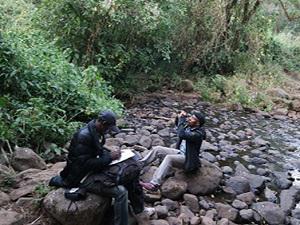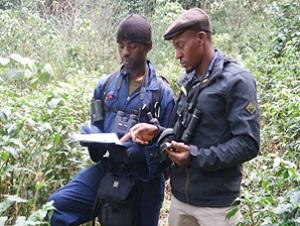Mfombo Didacus Tamambang
Other projects
9 Jan 2018
Consolidating Diet, Foraging Behavior and Conservation Actions of Bannerman’s Turaco in the Bamenda Highland Forest (BHF)
To ascertain the socio-cultural pressure on feather decoration against the conservation of the Bannerman’s Turaco and propose sustainable conservation measures through local participation.

Mfombo and Confidence at a bird count station in Laikom, Fundong.
The Bamenda Highland forest (BHF) is extra-ordinary diverse with high endemism. It is habitat for endemic plants, insects and birds. The critically endangered Bannerman’s Turaco is restricted to this forest. Habitat loss, resulting especially from forest fires and hunting of the species for feather harvesting are the greatest threats to the Bannerman’s Turaco. Moreover, increasing quest for farmland to produce food for the continuously increasing population has led to habitat fragmentation. Also, with the increase in the number of people decorated with feather from this bird yearly, the rate of its hunting has increased. The project seeks to contribute to the understanding of the social and cultural pressure of feather decorations against the conservation of Bannerman’s Turaco and propose sustainable conservation measures through local participation.

Mfombo and Senghore on bird survey in the Mt Mbam.
The project objectives are:
(i) to ascertain the socio-cultural pressure of feather decoration to the hunting of the Bannerman’s Turaco,
(ii) to update the population status, raise local awareness and make measures to reduce forest fires,
(iii) to establish a community driven conservation program through local participation.
Field research would include bird and socio-economic surveys. Socio-economic survey will include issuing of structured questionnaires and semi structured interviews in the 30 villages in the BHF. This will enable the understanding of the social push to the hunting of the species. The point count method used for bird survey by previous researchers in this landscape would be considered in the project. Furthermore, the trend detection – analytic framework of Forboseh & Ifkuingei, (2001) would be used to enable identification of changes in population trend and facilitate prioritization of which human impact (hunting for feather harvesting or forest fires) pose greatest threat to the species. The development of a conservation management plan will include the following activities: creating of new and strengthening of existing community conservation institutions, institutional empowerment via training and capacity building, establishing agro forestry systems, promoting apiculture and livestock rearing, support crop diversification and diverse species variety and improving community’s capacity to monitor and evaluate conservation actions.
Summarily, the expected project’s outcome is that alternative decoration options will be developed through integrated community action and also engaging communities in the establishment of sustainable conservation actions plan which will reduce forest fires and hunting of the species for feather harvesting. Furthermore, an understanding of the distribution, status and trend in the species population would be improved.